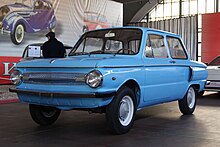ZAZ Zaporozhets


ZAZ Zaporozhets (
The name Zaporozhets translates into a
Zaporozhets is still well known in many former
Numerous special versions of the Zaporozhets were produced, equipped with additional sets of controls that allowed operating the car with a limited set of limbs, and were given for free or with considerable discounts to disabled people, especially war veterans - similar to
First generation (1960-1969)
| ||
|---|---|---|
Curb weight 665 kg (1,466 lb) | | |
| Chronology | ||
| Successor | ZAZ-966 Zaporozhets | |
ZAZ-965
The ZAZ-965 was a


The first prototype, the
One of the primary differences was that the
The new car was approved for production at the MeMZ factory on the 28th of November, 1958,[9] changing the name to ZAZ (Zaporizhzhia Automobile Building Plant) to reflect the new profile.[6] The Zaporizhzhia factory was supplemented with the Mikoyan Diesel-Building Factory in Melitopol, which was part of the Soyuzdiesel combinat.
The first car, dubbed the ZAZ-965 Zaporozhets, was delivered 12 June 1959,
There was also a
ZAZ-965A

The ZAZ-965A was an improvement on the ZAZ-965 and was produced from November 1962 to May 1969. In total, 322,106 units of the ZAZ-965 were produced.[6] It was powered by a
As Soviet drivers were expected to do much of the servicing themselves, and mechanics trained in the servicing of consumer automobiles were in short supply, the engine's 90° V4 layout proved more practical, especially in harsh winter conditions. The higher centre of gravity of the engine also provided superior traction on steep slopes, though this advantage, which was also continued in later models, came at the expense of the car's infamous lack of cornering stability.
The ZAZ-965A also had its versions for the disabled (ZAZ-965B, AB, AR), as well as a more luxurious export variant, the ZAZ-965AE Yalta.[6]
Despite the low prestige of those cars, they have shown an unbeaten accessibility and popularity among the people of the Soviet Union, becoming the "car for pensioners and intellectuals". They were the cheapest Soviet-made cars. Quite a large number of them were produced in variants for disabled people, with modified steering.[10]
Between November 1966 and May 1969 the ZAZ-965A and its successor, the ZAZ966, were produced concurrently.[12]
When production of the ZAZ-965 ended, 322,116 had been built.[12]
The ZAZ-965 also inspired the 1962 prototype
The ZAZ KD of 1969 was also based on the ZAZ-965, fitted with a glassfibre body,[13] giving it a weight of only 500 kg and a top speed of 75 mph (121 km/h) using just 30 PS (22 kW).[14] It was never produced in quantity, either.[14]
Second generation (1966-1994)
| ||
|---|---|---|
Curb weight
| ||
| Chronology | ||
| Predecessor | ZAZ-965A (Zaporozhets) | |
| Successor | ZAZ-1102 Tavria | |
ZAZ-966

The second generation of the Zaporozhets was a series of
While featuring a larger two-door
ZAZ launched an upgraded ZAZ-966B in 1968, powered by a new 40 PS (29 kW) 1,197 cc (73.0 cu in) MeMZ-968 V4, while the 30 PS ZAZ-966A-powered model became the ZAZ-966-1 which was only ever produced in small numbers.[12] The ZAZ-966B, weighing in at 780 kg (1,720 lb), was heavier than the earlier model, but faster, reaching 75 mph (121 km/h).[12]
The ZAZ-966 was discontinued in 1972, with the introduction of the ZAZ-968.[12]
Nicknamed "Zapo" in the Eastern Bloc, the ZAZ-966 also found some buyers in Western Europe, including Finland and France.[12] Some markets swapped the original engine for a 956 cc (58.3 cu in) Renault unit.[12]
ZAZ-968


The ZAZ-968 and its variants were produced from 1971 to 1980.
Toward the end of 1974, the up-market ZAZ-968A debuted, continuing in production until 1979.[13] Among its improvements was a padded dash, energy-absorbing (collapsing) steering column, and seats from the VAZ-2101.[13] The export ZAZ-968E (destined mostly for the Eastern Bloc) had headlights modified to meet international standards, a safety glass windscreen, and an anti-theft steering lock.[13]
ZAZ-968M


In 1979, the ZAZ-968 series was replaced by the modernized ZAZ-968M.
The ZAZ-968M was the last Zaporozhets model and also spent the most time in production, with cars being made from 1979 to 1 June 1994. By that time, the Soviet Union had collapsed, Ukraine had become independent, and modern, front wheel drive economy cars from the West like the Volkswagen Polo and Ford Fiesta had become available in quantity, vehicles which the 1950s and 60s designed Zaporozhets had no hope of competing with.[13] Some of its special variants include the ZAZ-968MB2, for drivers who had only one foot, and the ZAZ-968MB for drivers who had no feet.
Planned ZAZ-968s with 1,300 cc (79 cu in) or 1,400 cc (85 cu in) engines would never enter production, likely a side effect of the stagnation of Russia in the 1970s and 80s and the subsequent reign of Gorbachev, the fall of the Berlin Wall, and the breakup of the Soviet Union occupying more attention than a little Ukrainian-built economy car whose mechanicals dated back to 1959.[13]
Export versions
Among the export variants produced by ZAZ were ZAZ-965E, ZAZ-965AE, ZAZ-966E, ZAZ-968E, and ZAZ-968AE, which had improved features compared to vehicles made for the home market. Depending on target markets, the model names Jalta or Eliette were used for these cars.
In total, 3,422,444 Zaporozhets vehicles were manufactured in the Melitopol factory from 1960 to 1994, with all of them using the same family of air cooled V-4 engines mounted in the back.[17]
In popular culture
In the 1963 Soviet romantic comedy Three Plus Two, a ZAZ-965 with license plate number 18-15-лдг is featured in numerous scenes throughout the movie, and is even referred to directly in the script as "a tin can of the Zaporozhets system."[18]
In the 1995
In the 2011 animated feature film Cars 2, the Trunkovs (Vladimir, Petrov, Lubewig, and Tolga) are based on the ZAZ-968 Zaporozhets.
In the video game MudRunner, a car based on the ZAZ-965 is found in several maps named A-968M.
In Half-Life 2 the car is shown in dilapidated condition as a prop that clutters some roads.
It also appears as a prop in the S.T.A.L.K.E.R. games.
See also
Similar air-cooled and rear-engined vehicles:
- Chevrolet Corvair
- NSU Prinz 4
- Hillman Imp
- Hino Contessa
- Volkswagen Type 3
References
- ^ ISBN 978-5-9774-0409-9, (in Russian)
- ^ a b FIAT begins to produce Zaporozhets (in Russian)
- ISBN 978-0801461484.
- ^ ISBN 978-1-84425-483-5
- ^ Thompson 2008: "This was another example of how, in spite of its close visual similarity to the Fiat 600, the Soviet vehicle was in fact a completely different car..."
- ^ ISSN 2071-095X, (in Russian)
- ^ a b c d e Thompson 2008, p. 89
- ^ a b c d Thompson 2008, p. 92
- ^ a b c d e Thompson 2008, p. 90
- ^ ISSN 2071-095X, (in Russian)
- ^ a b c d e Thompson 2008, p. 200
- ^ a b c d e f g h i j Thompson 2008, p. 201
- ^ a b c d e f g h i j Thompson 2008, p.203.
- ^ a b Thompson 2008, p. 205
- ^ Thompson 2008, p. 199
- ^ Thompson 2008, p.204 & 206.
- ^ "Company's history". AvtoZAZ.com. Retrieved 15 October 2011.
- ^ "Ровно 60 лет назад в Запорожье начали выпускать ЗАЗ-965, прозванный в народе "Горбатым"". fakty.ua (in Russian). Retrieved 2021-12-22.
